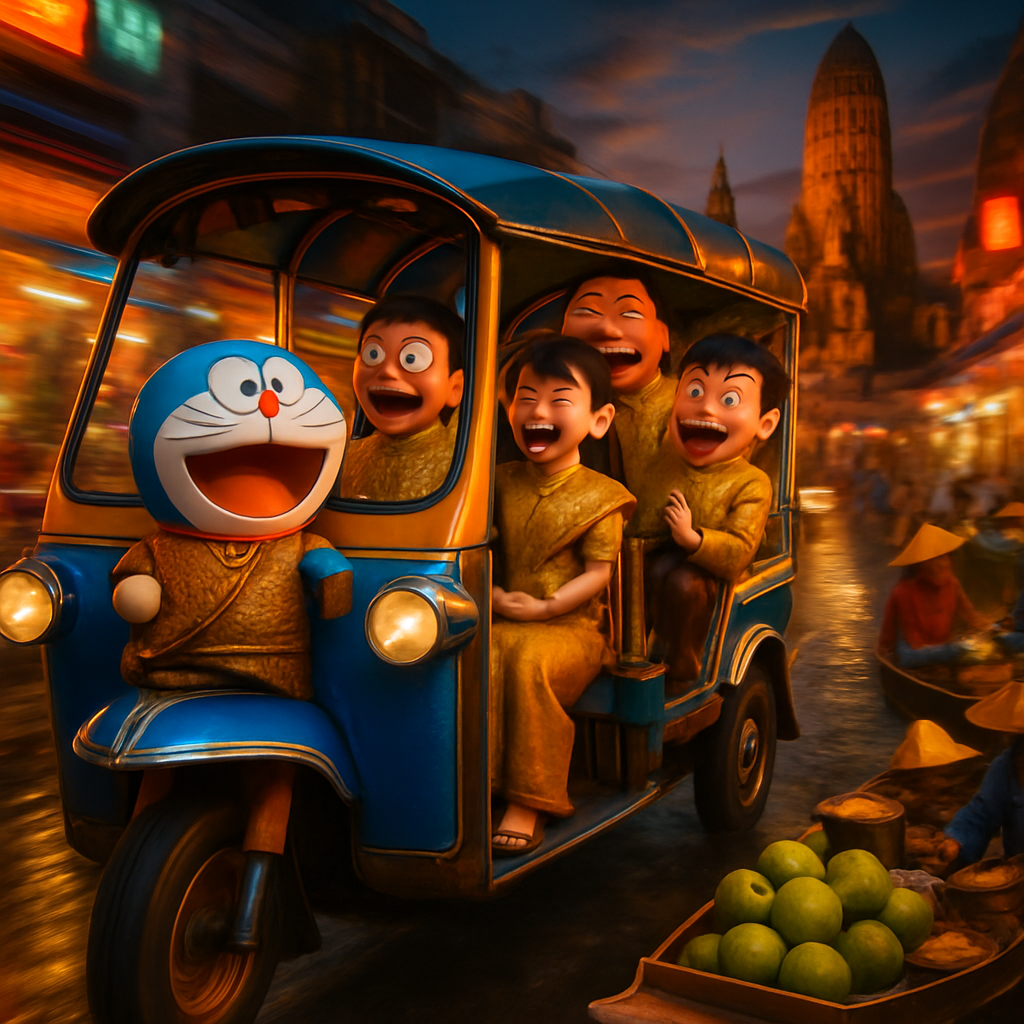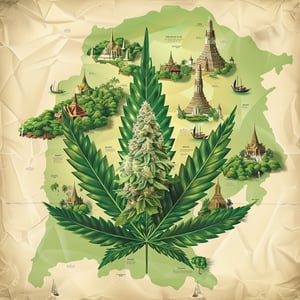Thailand’s streets are about to get a little more robotic and a lot more nostalgic — Doraemon and his whimsical crew are making their Thai TV debut. MCOT Plc confirmed that the special episode titled “I Want to Meet That Cat in Thailand” will air at 9:00 a.m. on Channel 30 this Saturday, September 6, giving fans both new and old a charming reason to gather around the screen.
Episode 865 — which first aired in Japan on TV Asahi on May 31 — has finally hopped from Tokyo to Bangkok after a little over three months of travel through syndication and translation. It’s been worth the wait: the storyline transports Doraemon, Nobita, Shizuka and the gang into the heart of Thailand, letting viewers tag along as the blue robotic cat discovers tuk tuks, temples, and tasty street food.
A cartoon trek through Thai classics
The animation plays like a love letter to Thailand. One memorable sequence sends our heroes bouncing through busy streets in a tuk tuk, the wind in their hair as neon signs and market stalls blur past. Another scene strolls through the archaeological grandeur of Ayutthaya, where crumbling prangs and ancient Buddha statues set a dramatic backdrop for Nobita’s trademark mix of mischief and heart. And for colour and chaos, the crew heads to Damnoen Saduak floating market in Ratchaburi province — a splashy, paddle-powered parade of vendors, curry, and coconuts.
Fans have been especially tickled by a scene showing Shizuka in elegant Thai traditional costume. Her graceful look hasn’t just been a visual treat; it’s a cultural wink that made many Thai viewers smile and tweet, post, and comment with pride.
Local buzz and playful reactions
MCOT’s Facebook announcement — “Tomorrow! That’s the day when Doraemon will be in Thailand” — quickly stirred lively conversation online. Some comments were tender: parents excited to introduce a beloved classic to their kids. Others were cheeky: one viewer on the FM96.5 YouTube channel joked, “I’m afraid Doraemon could be ripped off if he hails a cab,” riffing on cab-hailing quirks and fee-haggling that locals know too well.
The timing is fun, too. The screening arrives just after Doraemon’s fictional birthday, celebrated on September 3 — lore says he was born in Kawasaki City in 2112 before zipping back in time to help Nobita. The franchise’s blend of sci-fi whimsy and warm moral lessons is exactly the kind of family-friendly fare Thai networks hope will bond generations.
Why this matters beyond cute animation
Doraemon isn’t just a cartoon cat with a pocket full of gadgets — he’s a cultural ambassador. For decades, the character has connected Japan with other parts of Asia and the world, teaching lessons about friendship, responsibility, and imagination. That a special episode spotlights Thailand underscores the country’s rising cultural footprint and global appeal.
Seeing Damnoen Saduak’s floating market and Ayutthaya’s temples through the Doraemon lens is a simple but clever way to invite international viewers to learn about Thailand’s landscapes and traditions. For Thai audiences, the episode is a mirror: familiar places and customs portrayed with affection, humor, and a dash of cartoon magic.
What to expect — and how to watch
If you’re planning to tune in, expect about 20–30 minutes of light-hearted adventure, a smidge of slapstick, and plenty of feels. Channel 30 on MCOT will broadcast the episode at 9:00 a.m. local time on September 6. Families with young kids, longtime anime fans, and anyone who appreciates cultural cameos will likely find something to love.
Beyond the single episode, the broadcast signals something larger: an openness to more cross-cultural storytelling on Thai television, and a belief that timeless characters like Doraemon still have the power to bring people together — one gadget (and one tuk tuk ride) at a time.
So dust off the old plushies, prepare a plate of snacks, and set a reminder. Whether you grew up watching Doraemon or are meeting him for the first time, tomorrow’s episode promises a warm, colorful trip through Thailand — courtesy of everyone’s favorite time-traveling feline.


















Love that Doraemon is visiting Thailand, but is this just cute tourism advertising or genuine cultural exchange? I grew up watching the show and this feels nostalgic, yet I worry about shallow portrayals. Either way, I’ll watch with my niece and judge for myself.
It can be both—soft power and sincere tribute—depending on how respectfully they handled the locations. Even silly cartoons shape perceptions about a country.
As long as they don’t sell a tuk tuk toy with a price tag of a small house, I’m good.
Also curious whether the Thai dubbing preserves jokes or replaces them with local humor; that can change the whole tone. I hope Shizuka’s costume wasn’t just for exotic decoration.
This is classic cultural diplomacy through media, and Japan has done this for decades with anime. Some people shrug at cartoons, but they carry values and images that last generations. Thailand should take advantage and maybe create reciprocal content.
Reciprocal content would be cool, but Thai shows rarely get the same export push. We have to ask why distribution isn’t balanced.
Because budgets and global marketing teams, simple as that.
Seeing Ayutthaya and Damnoen Saduak in animation is beautiful, but cartoons can flatten history for laughs. I hope they didn’t turn temples into just Instagram backdrops.
As a history teacher I worry that simplified portrayals create misconceptions, yet visual media can spark curiosity. If kids see Ayutthaya and ask questions, that’s a win, but there should be follow-up resources. Broadcasters could include brief cultural notes or links for families to learn more.
Exactly, a short segment after the episode or a website link would make a big difference.
Doraemon trotting around the world is wholesome, but sometimes these episodes use stereotypes for cheap laughs. I hope Thai culture was treated with nuance and respect.
Stereotypes in kids’ media are tricky because young viewers internalize them. The best episodes show respect while still being playful.
Right, and costume appreciation has to avoid objectification; Shizuka’s Thai dress should be an example of genuine admiration.
I’ll watch just to see if Doraemon haggles over a tuk tuk fare or gets scammed by a street vendor.
Funny, but that joke cuts both ways; making locals the butt of the joke feeds stereotypes and feels lazy. Comedy that punches down is not clever.
Fair point, I just want slapstick and food scenes, not to punch anyone.
From a cultural studies perspective, Doraemon acting as a transnational mediator is significant; it maps Japanese imaginaries onto Thai spaces. This episode may contribute to a branded, touristic vision of Thailand rather than a lived, complex reality. Scholars should track how such media shapes tourist flows and local heritage narratives.
That sounds academic, but most viewers will just enjoy the cuteness and snacks. Not everyone reads journal articles before watching cartoons.
True, and that’s precisely why analysis matters: everyday pleasures can have cumulative cultural effects even if they’re not consciously political.
As a parent I welcome family-friendly programming that connects generations, but please keep the episode free of product placement. Kids already face enough commercial pressure.
I like Doraemon because he fixes problems with gadgets, but I don’t like ads in shows. Ads are annoying.
Exactly what my kid says, and we need broadcasters to respect that household space.
Doraemon’s gadgets are sci-fi charm, but I wonder if the tech is inspiring kids toward STEM or just wishful thinking. Animated wonder can be a gateway to curiosity if framed well.
It sparked my niece’s interest in simple mechanics, so there’s real educational potential. A companion kids’ segment on how a gadget could work would be great.
Yes, a makerspace tie-in or short explainer would turn passive watching into active learning.
People overthink cartoons; they’re meant to entertain, not solve geopolitics. Let the kids enjoy their favorite cat without turning every episode into academic fodder.
Entertainment can coexist with responsibility; creators and stations have audiences that include impressionable kids. A balance is possible and necessary.
Fair enough, but don’t police every frame—some of us just want nostalgia and morning cartoons.
I’m proud to see Thai landmarks featured internationally, but representation matters: were Thai voices consulted in the script or was it all external interpretation? That changes the episode’s legitimacy.
Such collaborations often vary; some productions hire local consultants, others simply use stock imagery. If local experts were involved, it strengthens cultural authenticity and mitigates appropriation concerns.
We should ask MCOT for production notes or credits that show local collaboration, transparency would calm many critics.
As someone from Bangkok, I’m excited but nervous about clichés. If they show real street food culture respectfully, I’ll forgive the dramatized tuk tuk chase scenes.
Please post if any scene feels wrong or inaccurate; local feedback could shape social media conversation and encourage more thoughtful portrayals in future episodes.